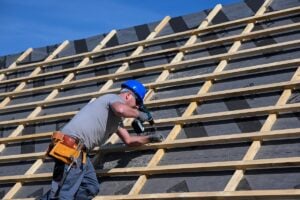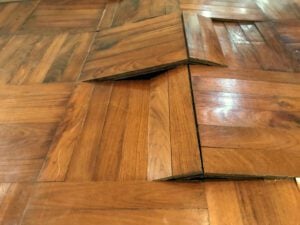Popcorn ceilings were once a popular mid-20th-century design feature. However, they can quickly become a homeowner’s nightmare when water damage strikes.
Whether caused by a leaky roof, a burst pipe, or HVAC condensation, moisture can penetrate popcorn ceilings, resulting in visible stains, sagging, or even mold growth. Because popcorn ceilings tend to trap moisture, damage often goes unnoticed until it becomes a larger problem.
This guide walks you through what to look for, how to fix popcorn ceiling water damage, and when it’s time to call in the pros at Allphase Restoration.
What Is a Popcorn Ceiling?
A popcorn ceiling is a type of textured ceiling finish commonly applied using a spray-on or paint-on treatment that creates a bumpy surface.
Often compared to the appearance of cottage cheese or popcorn, this finish was especially popular in homes built from the 1950s to the 1980s.
Popcorn ceilings were favored for their sound-dampening properties and their ability to hide imperfections in the ceiling surface. While easy to apply and cost-effective, they can be harder to maintain and repair than flat ceilings—especially after water damage.
Why Popcorn Ceilings Are Prone to Water Damage
Popcorn ceilings have a porous, uneven texture that absorbs and traps moisture more easily than flat ceilings. That means when a leak occurs, water can spread through the nooks and crannies of the texture, often going unnoticed until stains or sagging become visible.
Their popularity was largely due to affordability and sound insulation, but these benefits come at a cost. The textured surface can conceal slow leaks, making it harder for homeowners to spot early warning signs.
Once soaked, the popcorn material can crumble, flake, or even fall off in large patches.
Popcorn ceilings may also contain asbestos in older homes. If you’re unsure about the material used in your ceiling, it’s best to consult a professional like Allphase Restoration.
Step-by-Step Guide to Fixing Water-Damaged Popcorn Ceilings
This section provides a practical, step-by-step guide for homeowners who are confident in taking on light ceiling repairs.
Always use caution and the appropriate safety gear—and remember, if there’s any risk of mold or asbestos, call a certified restoration contractor right away.
Step 1 – Locate and Fix the Source of the Leak
The most critical step is stopping the source of water.
Before making any repairs to the ceiling, identify and address the issue causing the leak. This could be a roof leak, burst pipe, plumbing issue, or HVAC condensation.
Check the area above the damaged ceiling; bathrooms and attics are common culprits. If the leak is ongoing or severe, shut off water sources and schedule immediate repairs.
Repairing the ceiling without fixing the root cause will only cause more damage.
Step 2 – Protect the Area and Wear Safety Gear
Prepare your workspace to stay safe and prevent a mess. Popcorn ceiling texture can crumble easily, releasing dust or even mold spores.
Make sure all of your furniture is either covered or removed and that there is plenty of ventilation. You should also wear gloves, safety goggles, and a mask or respirator.
If there’s any concern about asbestos, stop and call a certified contractor.
Step 3 – Remove the Damaged Popcorn Texture
Gently scrape away the damaged popcorn material. Make sure the ceiling is completely dry before attempting removal. Use a putty knife or ceiling scraper to gently remove stained or softened areas.
If the texture is hard to scrape, lightly mist the surface with water to soften it. Just avoid soaking the ceiling.
Again, if you suspect your popcorn ceiling contains asbestos, do not scrape it. Hire a licensed abatement professional instead.
Step 4 – Repair the Drywall or Ceiling Surface
Now you can repair the ceiling underneath the removed texture.
Damaged drywall or substrate must be repaired before reapplying any finish. Use a patching compound for small holes or cracks; warped or sagging drywall should be cut out and replaced.
Once repaired, let it dry completely, then sand it smooth and level to ensure a uniform finish. Use a primer at this stage if water stains are still visible on the patched area.
Step 5 – Reapply Popcorn Texture (If Desired)
Once the ceiling surface is repaired and smooth, you can choose to reapply a popcorn finish or switch to a different texture.
You can find a can of spray-on popcorn ceiling texture at most hardware stores. However, some homeowners take this opportunity to switch to a different ceiling texture.
It’s always important to test a small area of the ceiling before applying a new texture.
Step 6 – Prime and Paint
Seal the area to block stains and restore appearance. Before applying paint, the repaired section must be primed with a stain-blocking primer to prevent bleed-through. Choose a primer designed specifically for water stains or smoke damage.
After priming, use ceiling paint to match the rest of the room’s color scheme. Apply paint using a roller with a thick nap or a spray can for even coverage on textured surfaces.
Important: Don’t skip the primer! Skipping the primer can result in yellow or brown water stains reappearing after painting.

Signs of Water Damage on Popcorn Ceilings
Popcorn ceiling water damage often presents visible and olfactory clues. Here are the most common signs to watch for:
- Brown, yellow, or rust-colored stains
- Sagging or bulging areas in the ceiling
- Peeling or flaking paint
- Soft or crumbling texture
- Small bubbles or blistering patches
- Drooping sections of ceiling material
- Musty or damp odors near the ceiling
- Visible mold spots or dark streaks
Early detection can limit the extent of damage and reduce the need for major repairs.
Can You Paint Over Water-Stained Popcorn Ceilings?
Technically, yes—but it’s not a solution.
Painting over a stained popcorn ceiling can temporarily improve appearance, but it does not address the underlying cause of the damage. If the ceiling is still wet, unstable, or contaminated with mold, painting will only mask the issue.
When to Call a Water Damage Restoration Professional
While minor popcorn ceiling repairs are manageable for DIYers, some situations call for expert help. If you notice any of the following, it’s time to contact a certified water damage restoration company:
- The ceiling is sagging, unstable, or at risk of collapse
- Mold is visible or suspected
- You’re unsure if the popcorn texture contains asbestos
- The water damage is widespread or worsening
- You want fast, safe cleanup with professional results
Allphase Restoration offers comprehensive restoration services for homes impacted by ceiling leaks, plumbing failures, storm damage restoration, or other major water events. Their team ensures proper remediation, repairs, and cleanup, with less stress for homeowners.
Why Choose Allphase for Popcorn Ceiling Water Damage Repair?
At Allphase Restoration, we understand the stress and urgency that comes with ceiling water damage.
With countless positive reviews and a dedicated team of certified professionals, Allphase is a trusted name in Ohio for residential and commercial restoration.
- IICRC-certified technicians
- Mold remediation specialists
- Same-day water damage restoration
- Seamless repairs
We handle everything from flooded basement cleanup to ceiling restoration, giving you peace of mind throughout the process.
Contact Allphase for Cleanup & Restoration Services
If your popcorn ceiling has been stained, sagged, or damaged by water, don’t wait for the problem to get worse.
Allphase Restoration is here to help with inspection, repair, and full-service remediation. We’ll assess the issue, fix the source of the leak, and restore your ceiling safely and efficiently.
Contact Allphase Restoration today to schedule your consultation or request emergency support.
Water Damage on Popcorn Ceilings FAQs
1. How much does it cost to repair a water-damaged popcorn ceiling?
The cost varies depending on the extent of the damage and whether professional help is required. Minor DIY repairs (like scraping and repainting) might cost under $100.
If you need to replace drywall, address mold, or hire a certified contractor, the cost of repairs can range from $500 to over $2,000.
For accurate pricing, request an estimate from a local provider.
2. Can popcorn ceiling texture grow mold after water damage?
Yes. The bumpy surface of popcorn ceilings can trap moisture, making them especially vulnerable to mold growth. If the area smells musty, shows dark spots, or feels soft to the touch, it’s best to call a professional for inspection and mold remediation.
Allphase Restoration specializes in mold removal tied to ceiling leaks and other water issues.
3. What happens if you ignore water damage on a popcorn ceiling?
Ignoring popcorn ceiling water damage can lead to more serious issues, including structural damage, mold growth, and worsening leaks.
Over time, the ceiling material can fall, creating safety hazards and affecting your home’s value.
4. Are popcorn ceilings more likely to suffer water damage than flat ceilings?
Popcorn ceilings tend to show water damage more dramatically. The textured surface holds moisture and can hide early signs of a leak, which often delays detection. Popcorn texture also deteriorates faster than a flat finish.
5. How long does it take for a popcorn ceiling to dry after a leak?
Drying time depends on the severity of the leak, the type of ceiling material, and indoor humidity levels. On average, a water-damaged ceiling may take 24 to 72 hours to fully dry with proper ventilation. Using fans and dehumidifiers can accelerate the process.
6. What if the popcorn ceiling starts falling down after water damage?
This is a sign of severe moisture saturation or structural compromise. Do not attempt to patch it without first addressing the water source and inspecting for mold or hidden damage.
In cases of partial collapse following water or fire damage, consult a restoration expert immediately.




